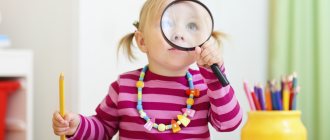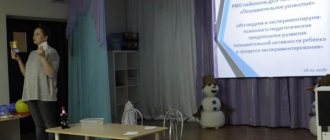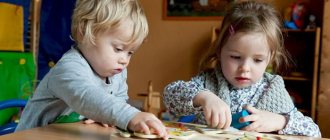The universal “sequential pictures” technique, which psychologists often use to determine a child’s readiness for school, can also be used by parents at home. It helps to understand how appropriate the child’s level of intellectual development is for his age and to identify possible problems in time.
Description of the technique
The essence of the method is to test the preschooler’s ability to grasp cause-and-effect relationships and compile a complete description of the resulting sequence of pictures.
The child’s work with the proposed material includes two stages:
- Arrange several images related to each other in meaning, but mixed, in a logical chain.
- Write a coherent story based on the pictures.
Depending on the age of the preschooler, there may be a different number of images, usually from 3 to 6. The teacher lays out cards in front of the test subject and asks them to arrange them in order. Several parameters are recorded in the protocol and taken into account when assessing the result:
- the time it took the child to create a logical chain;
- number of mistakes;
- the way the preschooler put together the pictures and corrected mistakes (if any) - himself or with the help of leading questions from a psychologist.
The next stage of testing is composing a story according to the resulting sequence. Usually the number of sentences in the description corresponds to the number of cards with pictures themselves. This result is considered normal. The highest level is determined by a detailed story using relatively complex grammatical structures and the presence of an emotional component (the child expresses his attitude to the events described).
Without the necessary level of development of basic skills, children will find it difficult to master the school curriculum. That is why the above method of analysis is especially relevant for preschoolers aged 6–7 years.
The test allows you to evaluate several parameters at once that are important for a future first-grader:
- logical thinking;
- imagination;
- speech.
A similar “tell by picture” technique is used for the same purpose. In this case, you do not use a set of cut cards that can be mixed, but a ready-made sequence of 4 or more drawings. Here, when assessing the results, experts pay main attention to the child’s active vocabulary, counting the number of parts of speech used in various forms, as well as complex sentences and constructions.
Methods for diagnosing thinking in preschool children
Visual-effective thinking is diagnosed in preschoolers using fairly simple techniques, such as, for example, Seguin boards, “Mailbox”, etc.
Diagnostics of visual-figurative thinking
“Nonsense” technique
The technique is aimed at identifying the child’s understanding of the simplest connections, the relationship between animals and nature, as well as his ability to reason logically. The technique consists of presenting the subject with a picture depicting animals in absurd situations, the child needs to point out the inconsistencies, explaining what is wrong, then he needs to tell how this or that character should behave correctly. You have 3 minutes to complete the task.
If during this time the child finds all 7 absurdities depicted and manages to tell how it should really be, he receives the highest score, confirming a high level of visual-figurative thinking. When a subject fails to find more than four inconsistencies in a drawing, this indicates poorly developed visual-figurative thinking.
Trace the outline
As material, figures are given, only half of which are shown in outline in the figure. The goal is to accurately replicate the left half of the image on the right side. Based on the results of the work, the speed of its completion, accuracy (the outlines of the figures are depicted in the same places as on the left side, the corners are accurately connected) and accuracy (the lines are drawn straight) are assessed. The highest score is given to children who spent less than 90 seconds on the work and completed their half of the image, accurately repeating the sample. The lowest score is awarded to preschoolers who complete the task in more than 150 seconds if the lines are not straight and the angles are connected incorrectly.
Finding the missing parts of the picture among those offered to choose from
In tasks of this type, the preschooler must find the missing fragment. Considering that most of the image is given, the child should have a complete image, based on which he can find the missing fragment like a puzzle. There are similar tasks where only part of the image is given and you need to understand what kind of whole image is hidden behind it.
Doing exercises with children in English
Tasks to find objects united by some common feature (generalization and classification)
In this type of task, it is proposed to combine objects according to image and likeness or functionality into groups or sort them according to the same criteria. For example, you are given a set of items, among which you need to find something that can be useful at school or on a hike, something that a doctor or cook uses. Children are also asked to combine drawings into pairs according to their purpose (for example, fork + knife), color (tomato + strawberry), shape (ball + orange), relationship (saw + log), etc.
Tasks to find patterns
In such tasks, you are given a series with repeating objects, the pattern of alternation of which you need to catch (leaf, flower, leaf, skip, leaf) or a series where the object changes incrementally and you need to guess what it will look like on a certain segment of the path (circle - circle with arrows - hours), etc.
Fourth wheel
The tasks contain images of objects, among which you need to find one extra one. The remaining pictures need to be combined under one name. For three-year-old children, this could be a set: fox, hare, ball, wolf (an extra ball, the rest are animals). Further, the task becomes more complicated, for example, drawings are given: a fox, a hare, a giraffe, a wolf (an extra giraffe, since the rest of the animals live in the forest).
Diagnosis of creative thinking
It is a recognized fact: creativity is more a process than an end product. A creative approach to business means setting a problem for yourself and finding ways to best solve it.
That is why a person with creative abilities is distinguished by a strong need to learn new things. A high level of cognitive activity begins to manifest itself at an early age, when the child is just beginning to explore the world. It’s easy to see its manifestations by watching the baby:
- emotional reactions to new toys, objects, situations manifest themselves vividly and find a positive response to changes;
- great interest is shown in new people, ways of behavior, knowledge;
- high need for imitation, repetition of heard words and actions.
Questions from creatively inclined children can come as a surprise to parents and cause confusion, because... The inquisitive minds of children delve deeper into the question of interest. At age 5, inquisitive minds begin to conduct experiments, trying to find answers on their own. Also, at 5-6 years old, the growing level of need to understand the world around us pushes the child to try to answer his own questions. The search for solutions to problems is carried out systematically and consistently. Closer to primary school age, the child has a need to share his discoveries with his immediate environment.
To assess the creative abilities of children in psychology, a number of criteria identified by the American scientist P. Torrence are used:
- productivity;
- flexibility;
- originality;
- development of creative ideas and solutions.
To assess the creative abilities of preschool children, methods are used that give room for imagination; in the process of working on a task, the child can express himself and reveal his creative potential.
How to dramatize fairy tales in secondary groups of preschool educational institutions
Download material: Diagnostics of thinking of preschool children
Methods for diagnosing the creative abilities of preschool children
Methodology for evaluating a fairy tale written by a child by O.M. Dyachenko and E.L. Porotskaya
During the study, children are asked to compose their own fairy tale, then its productivity, originality and variability are assessed. The lowest score is given to participants who refuse the proposed task or retell a well-known fairy tale. The highest score goes to children who managed to independently come up with a fairy tale and present it in detail.
P. Torrance test for creative thinking (adapted by N.B. Shumakova, E.I. Shcheblanova, N.P. Shcherbo)
The method contains two figures (a drop and a bean), a form with unfinished contours of images and a form with repeating lines, which are used to solve three problems (each takes 10 minutes):
- “Draw a picture” - test shapes are used to create a picture. The original forms can be supplemented with the necessary details, and then you need to come up with a name for the resulting picture.
- “Unfinished Shapes” - the child is asked to imagine what the original 10 unfinished shapes might look like. Each of them is tied to a stable image, but the more creative the created image, the more creative the preschooler’s thinking is. Each completed picture must be given a title.
- “Repeating figures” - the preschooler is given a form on which repeating paired lines are depicted. From each pair of lines you need to create a drawing. For this task, it is important to draw without repetition, coming up with different images.
Evaluation of completed work is carried out taking into account productivity, flexibility, originality and detail of completed tasks.
Creative task “Show how he moves and speaks”
This technique uses cards with images of animate and inanimate objects. For each of them, the child needs to come up with a speech, a manner of speaking, a language and a way of moving. After the presentation of the constructed images, an assessment occurs: a high level of creative thinking is characterized by the accuracy, integrity of the presented image and the expressiveness of its presentation; at a low level the image is not conveyed accurately and expressively.
Creative task “Three colors”
The preschooler is asked to choose three colors that match each other and fill the entire sheet with them. Next they ask what this drawing looks like, what it reminds the child of. If a preschooler has difficulties, it is allowed to add missing details to the drawing. After recognizing the images hidden in the drawing, the child is asked to come up with as many names for it as possible. The more the subject can see images and come up with interesting names for the image, the better his creative thinking is developed.
Thanks to this exercise, you can not only diagnose creative thinking, but also develop imagination and artistic perception.
Creativity, as a psychological process, is multifaceted, and therefore requires complex diagnostics to obtain reliable results.
Advantages and disadvantages of the technique
Like any other tool for assessing the level of development, the “sequential pictures” technique has its advantages and disadvantages. Its undoubted advantages are as follows:
- Ease of implementation. Finding a series of pictures on the Internet and printing it is not difficult for either teachers or parents. It's easy to select the desired difficulty level. Any mother can evaluate the quality of work, at least approximately.
- Demonstration. The test helps not only to assess the intellectual capabilities of a healthy child, but also to identify possible delays in mental development. If by the age of 6 the child finds it difficult to describe pictures even with the help of leading questions, this is a signal for parents that they need to consult a specialist.
- Developmental effect. In itself, completing such tasks is very useful for preschoolers starting from 4 years old. Games based on the analysis of sequential pictures train the same abilities that the test evaluates - logic and speech.
The disadvantages of testing are mainly related to the human factor, both on the part of the test subject and on the part of the inspection commission:
- Distortion of the result due to the individual characteristics of the child. By the age of 6–7 years, the personality of a preschooler has already largely developed - everyone has their own character. Some people willingly demonstrate their vocabulary, reasoning out loud already at the stage of drawing up a logical sequence, while others have difficulty choosing words for fear of making a mistake or feel constrained in front of strangers in an unusual environment.
- Subjectivity of assessment. Sometimes belonging to different generations prevents the child and the psychologist from coming to a common understanding of the meaning of the task. For example, if a child has seen a video on the Internet with goats climbing trees or cats that like to swim, he gives the commission relevant information, which is assessed by elders as false and raises doubts about the level of development of the preschooler.
- Child's uncertainty. This point follows from the previous one: often children are not able to defend their position if an adult makes it clear that the answer does not meet his expectations. Therefore, other tests, such as generalization and imagination, are required to get a clearer picture.
The success of the technique depends on many factors, but basically it shows results that are close to objective, especially if the child is a pupil of a preschool educational institution. The ability to behave in such situations is also a very important trait of a developing personality; it will be useful to a child already in the first grade.
Games based on the technique
It is advisable to start exercises based on sequences of pictures at an early age, at home or in kindergarten. This is necessary not so much to prepare for the test, but for the development of the kids. For the little ones, pictures depicting a single object that changes over time are suitable: for example, a flower growing from the ground, or a melting snowman.
Making a clay pot
This type of exercise can be offered to a 3-year-old child. It is important that in this case we are not testing speech, but only logical thinking, so the adult tells the story himself, writing it into the task itself:
- Lay out three cards in front of the baby, rearranging, for example, the last two.
- Invite the child to play potter, arranging the corresponding pictures in the correct order: “First we sculpt the pot itself, then we make handles for it, and now we add a lid.”
- Mix the cards and ask the child to correct the resulting mistakes.
Depending on how successfully the child accepts the game, it should be complicated or simplified. If he is not yet able to independently arrange the pictures in the correct order, he should not insist or show dissatisfaction in any way.
To make it more interesting for your little one to complete the task, give it a playful form: come up with a funny name for the potter, offer to paint the pot.
Ask me!
A game for older preschoolers aimed at developing speech skills. Best suited for a group of 3-5 children, with an adult supervising and, if necessary, directing the gameplay:
- Children are offered a sequence of 4–6 pictures, which they work together to build into a logical chain.
- One of the players is declared a “student”, and the rest make up the “commission”.
- Members of the “commission” take turns coming up with and asking questions to the “student” based on the first 1-2 pictures, which he tries to answer. Then the role of the driver passes to the next participant.
The number of pictures must be calculated in such a way that there is enough for all players. In addition to speech, the exercise develops imagination and communication skills, provides a useful experience of mild stress, and introduces children to new sensations, similar to those they will face at an interview before school.
Understanding logical structure and improving the skill of composing a story from pictures precede elements of working with text. Already at the beginning of the second grade, students should be able to complete assignments based on several proposed paragraphs. Therefore, teachers and psychologists attach great importance to the “sequential pictures” technique in the preparation of older preschoolers.
Diagnostics of the cognitive sphere of preschoolers 3-4 years old
Diagnostics of the cognitive sphere of preschoolers 3-4 years old was prepared on the basis of: Pavlova N.N., Rudenko L.G. Express diagnostics in kindergarten: A set of materials for educational psychologists in preschool educational institutions.
After a preliminary conversation and establishing contact with the child, he is asked to complete the following tasks.
Subtest 1. “Box of shapes” (perception)
Goal: assessment of the degree of formation of the perception of shape and spatial relationships, the ability to analyze the location of figures in space.
Procedure. The insert figures are laid out in front of the child and a box with slots (Se-gen board) is placed (Fig. 2), the figures are taken out. Instructions: “Figures live in this house. Each has its own door. Find a door for each figure."
Criteria for evaluation
- The child completes the task based on visual correlation - 2 points.
- The child often tries it on, places the insert figure into the appropriate slot and completes the task correctly - 1 point.
- The child did not cope with the task - 0 points.
The Protocol notes whether the child completed the task and how he acts - by visual correlation or trial and error; in the “Notes” section, the child’s statements while completing the task are recorded; you can also ask the child to name and show familiar figures (for example, a square, triangle) and note whether he coped with this task.
Subtest 2. “Matryoshka 3-component” (thinking)
Purpose: to identify the child’s understanding of the instructions, the formed concept of quantity; assessment of the level of developed visual and effective thinking.
Procedure. The child is shown a matryoshka doll, the psychologist disassembles it and then puts it back together. After this, the nesting doll is placed in front of the child and he is invited to do the same. In addition, the child is asked to show the largest matryoshka doll, the smallest one, and put them in order of height.
Criteria for evaluation
- The child understands the instructions and independently disassembles and assembles the nesting doll through trial and error - 2 points.
- The child completes the task with the help of an adult - 1 point.
- The child does not cope with the task - 0 points.
The Protocol records how the child completed the task, in the “Notes” section - whether he was able to arrange the nesting dolls according to height.
Subtest 3. “2-3-component cut pictures” (thinking, perception) (See Appendix)
Goal: assessment of the formation of visual-effective thinking, the degree of mastery of visual synthesis (combining elements into a holistic image).
Procedure. A picture cut into two parts is laid out in front of the child. The parts are laid out so that they not only need to be moved together, but given the desired spatial position. An adult asks: “What do you think is drawn in this picture? What do you get when you put the pieces together?”
After completing the task, the picture is removed and the child is asked to assemble another picture, already cut into three parts.
Criteria for evaluation
- The child recognized what was drawn in the picture and correctly assembled the pieces in both cases - 2 points.
- The child completed the task by trial - 1 point.
- The child composes pictures after numerous inadequate trials or fails to complete the task - 0 points.
In the Protocol it should be noted whether the child was able to recognize the image and how many trials he made; in the “Notes” section it is recorded which hand the child is working with.
Subtest 4. “Colored cubes” (perception)
Goal: assessment of the ability to perceive colors, correlate them, find the same ones, knowledge of color names, ability to work according to oral instructions.
Procedure. The psychologist and the child each have the same set of colored cubes (blue, yellow, green, red). The psychologist takes one of the cubes and invites the child to show the same one. The tasks with all the cubes are performed in the same way. The child is asked to show the red cube, then the blue, yellow, green. The psychologist takes the cubes one by one and asks what color they are.
Criteria for evaluation
- The child correctly shows and names the colors of the cubes - 2 points.
- The child shows the blocks correctly, but is confused about the names of the colors - 1 point.
- The child does not cope with the task - 0 points.
The Protocol should note how the child performs each of the three tasks, the names of which colors he does not know.
Subtest 5. “Paired pictures” (attention, general awareness) (See Appendix)
Purpose : assessment of the ability to concentrate attention on presented objects, observation, visual memory.
Procedure. Pictures are laid out in front of the child. The psychologist has a similar set. The child is presented with pictures one by one, asked to find the same one and say what is depicted on it.
Criteria for evaluation
- The child correctly said what was shown in the pictures and found the pairs - 2 points.
- The child correctly named 3-5 pictures, but had difficulty completing the task - 1 point.
- The child named less than three images in the pictures and could not find pairs - 0 points.
The Protocol notes which items are named incorrectly and which words have replaced the correct names.
Subtest 6. “Guess what’s missing?” (memory)
Purpose: assessment of the level of development of involuntary memory, understanding of instructions, attention.
Procedure . Six toys are placed in front of the child and asked to name them, then the child closes his eyes, and the psychologist removes two toys: “Now the toys will play hide and seek with you. You close your eyes, and some toys will hide. When you open your eyes, you will have to tell which toys are missing.”
Criteria for evaluation
- The child remembered 2 toys - 2 points.
- The child remembers 1 toy - 1 point.
- The child did not name a single hidden toy or did not understand the instructions - 0 points.
The protocol records how many toys the child remembers.
Downloaded: 1369, size: 266.3 KB, date: 05 Jul. 2019
Downloaded: 1212, size: 234.9 KB, date: 05 Jul. 2019





